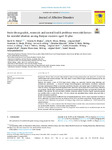Socio-demographic, economic and mental health problems were risk factors for suicidal ideation among Kenyan students aged 15 plus

View/
Date
2022-01Author
Ndetei, David M.
Mutiso, Victoria N.
Weisz, John R.
Okoth, Consolate A.
Musyimi, Christine
Muia, Esther N.
Metadata
Show full item recordAbstract
Background: About a third of youth with suicidal ideation develop suicidal plans and about 60% of youth with
suicidal plans make suicidal attempts. This study aimed to study different types of suicidal ideation and the risk
factors in Kenyan youth.
Methods: We studied a total of 9742 high school, college and university students using following selfadministered instruments: - a researcher design socio-demographic questionnaire, Psychiatric Diagnostic
Screening Questionnaire (PDSQ) to document psychiatric disorders and various types of suicidal ideas in previous two weeks, Washington Early Recognition Center Affectivity and Psychosis tool to assess stress, affectivity
and psychosis, Wealth index questionnaire to document economic indicators based on household items for the
families of the students. We used descriptive statistics, univariate analysis, bivariate logistic regression analysis
and variables with a p-value of less than <.05 were entered into generalized linear models using logit links to
identify independent predictors.
Results: The overall prevalence of different types of suicidal ideation was (22.6%), major depression was found in
20.0%, affectivity, psychosis and stress was found in 10.4%, 8.7% and 26.0% respectively. Female gender, major
depression, stress, affectivity and psychosis and being in high school were significant (p < 0.05) predictors of
suicidal ideation.
Limitations: This was a cross sectional study that focused only on suicidal ideas and associated economic factors
and mental health disorders. It did not study suicidal behavior.
Conclusion: Future studies are needed to study the progression from suicidal ideas to suicidal attempts and the
factors associated with that progression.
